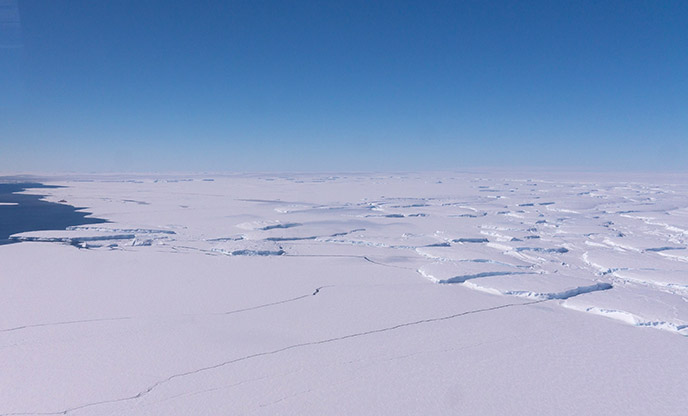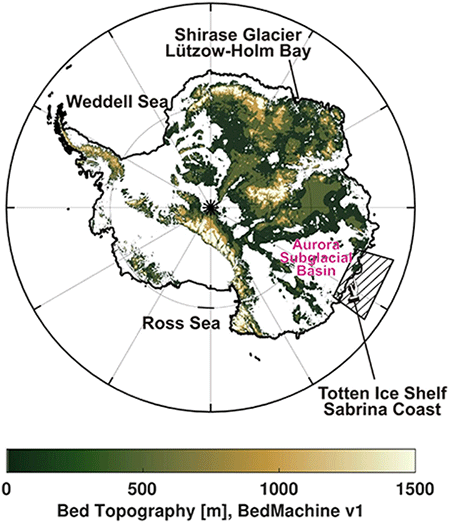National Institute of Polar Research
Large semi-stationary eddies whip warm water toward melting East Antarctic ice shelf
Released on October 26 2021 (in Japanese)
Posted on November 10, 2021
East Antarctic ice sheets and ice shelves were until recently thought relatively safer than their West Antarctic counterparts. Observations of melt and flows of warm water poleward from offshore have corrected this understanding, but the mechanism of such flows has remained a mystery. Researchers have now identified the transport mechanism, findings that should help with better sea-level rise predictions.

Totten Glacier, East Antarctica
Warm circumpolar deep waters flowing toward the Antarctic continental shelf were recently identified as causing ice shelf melting on the eastern half of the continent, not just in the west. But the precise mechanism of transport of these warm water flows from further offshore has until now remained unknown.
Japanese scientists from the National Institute of Polar Research have now however identified the cause as large, semi-stationary eddies off the Wilkes Land coast whipping the water poleward, a finding that should lead to more accurate predictions of global sea-level rise.
The findings were published in the journal Communications Earth and Environment on August 6.
It has been known for some time that mass loss of the Antarctic ice sheet in West Antarctica (the smaller ‘half’ of the Antarctic continent, separated from much larger East Antarctica by the Transantarctic Mountains) has been contributing to global sea level rise over many decades. Recent studies however have shown that ice mass loss in the Wilkes Land sector in East Antarctica has also been contributing to sea level rise for some 40 years.
This ice discharge into the sea, the largest in the eastern part of the continent, comes from the Totten Glacier, a colossal volume of ice that sits atop the southern continent’s land mass. The similarly named Totten Ice Shelf meanwhile is a block of ice connected to and buttresses the Totten Glacier, but floats atop the sea rather than sitting atop the land. The ice shelf works as a sort of ‘plug’ that normally prevents the Totten Glacier, and the expansive ice in the Aurora Subglacial Basin behind it, from sliding into the ocean. If the plug were removed via melting, this could increase sea levels by more than 3.5 meters (11 feet).
Worryingly, the point at which the Totten Glacier touches the sea (its ‘grounding line’) lies far below sea level, which means that a cavity of water can open up between the continental shelf and the underside of the ice shelf, and even under parts of the glacier itself. This makes both of them vulnerable to melting if oceanic heat flows into this underside cavity (so-called ‘basal melting’).
In the Southern Ocean that surrounds Antarctica, the strongest source of such oceanic ‘thermal forcing’ right across the continent is the warm Circumpolar Deep Water (CDW). The CDW is a product of a mixture of warm, relatively deep and salty waters flowing into it from the rest of the planet’s oceans and sits beneath a layer of colder, less salty surface waters. It is in turn drawn from the intermediate depths of the much larger Antarctic Circumpolar Current (ACC) further offshore and that swirls around the southern continent. It is thought that changes in the flows of warm CDW towards the continental shelf has an impact on this worrisome basal melting.
For some time, it was not thought that East Antarctica was as vulnerable to basal melting, as the continental shelf in the east is typically occupied by colder waters than the west.
However, recent hydrographic observations (measurements of water properties from ocean surface to bottom) have revealed warm inflows of CDW at the ice fronts of the Totten Ice Shelf (and those of the Shirase Glacier Tongue elsewhere in East Antarctica) as well. These measurements are also consistent with satellite observations of high basal melt rates for these regions. Taken together, these data are firm observational evidence of a warm ocean–cryosphere interaction beneath the floating Totten Ice Shelf (and the Shirase Glacier Tongue), which is otherwise unusual in East Antarctica.

The latest bed topography over the Antarctic Continent from the BedMachine Antarctica v1 (Morlighem et al., 2020)
But the precise mechanisms of how the offshore-origin warm CDW flows are transported from the ACC to the continental slope and the cavity beneath the Totten Ice Shelf have until now remained something of a mystery.
So the researchers carried out hydrographic observations at the continental slope and where the shelf begins to break up, but more closely spaced ones this time, and then combined this with ocean circulation data from satellites. These data when combined showed that there were cyclonic eddies of water that are semi-stationary off the Sabrina Coast of Wilkes Land and work to whip the warm waters poleward.
“The warm CDW circulation from the offshore ACC to the shelf break appears akin to an intricate ‘highway junction’ with some ‘fueling stations’ provided by multiple eddies off the Totten Ice Shelf on the Sabrina Coast,” said Daisuke Hirano, an assistant Professor at National Institute of Polar Research and a lead researcher involved with the study.
Having identified the mechanism for transport of warm offshore waters poleward, the team now wants to extend their analysis to understanding the interaction between these ocean waters and the ice directly at the underside of the Totten Ice Shelf. Taken together, this should assist the development of better predictions of global sea-level rise.
Original article:
Journal: Communications Earth & Environment
Title: Poleward eddy-induced warm water transport across a shelf break off Totten Ice Shelf, East Antarctica
Authors:
Daisuke Hirano (National Institute of Polar Research, Japan)
Kohei Mizobata (Tokyo University of Marine Science and Technology, Japan)
Hiroko Sasaki (Japan Fisheries Research and Education Agency, Japan)
Hiroto Murase (Tokyo University of Marine Science and Technology, Japan)
Takeshi Tamura (National Institute of Polar Research, Japan)
Shigeru Aoki (Hokkaido University, Japan)
DOI: 10.1038/s43247-021-00217-4
URL: https://doi.org/10.1038/s43247-021-00217-4
Published Online: August 6, 2021
Funding:
This work was supported by Grants-in-Aids for Scientific Research (JP20H04961, JP20K12132, JP17H06316, JP17H06317, JP17H06322, JP17H01615, JP20H04970, and JP21H04931) of the Ministry of Education, Culture, Sports, Science and Technology, the Science Program of Japanese Antarctic Research Expedition (JARE) as Prioritized Research Project, National Institute of Polar Research (NIPR) through Project Research KP-303, the Center for the Promotion of Integrated Sciences of SOKENDAI, and the Joint Research Program of the Institute of Low Temperature Science, Hokkaido University.








